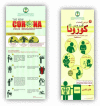Infection control and prevention practices implemented to reduce transmission risk of Middle East respiratory syndrome-coronavirus in a tertiary care institution in Saudi Arabia
- PMID: 26922892
- PMCID: PMC7115292
- DOI: 10.1016/j.ajic.2016.01.004
Infection control and prevention practices implemented to reduce transmission risk of Middle East respiratory syndrome-coronavirus in a tertiary care institution in Saudi Arabia
Abstract
Background: Transmission of Middle East respiratory syndrome-coronavirus (MERS-CoV) among health care workers (HCWs) and patients has been documented with mortality rate approximating 36%. We propose advanced infection control measures (A-IC) used in conjunction with basic infection control measures (B-IC) help reduce pathogen transmission. B-IC include standard and transmission-based precautions. A-IC are initiatives implemented within our center to enhance effectiveness of B-IC.
Objective: Study effectiveness of combining B-IC and A-IC to prevent transmission of MERS-CoV to HCWs.
Methods: A retrospective observational study was undertaken. A-IC measures include administrative support with daily rounds; infection control risk assessment; timely screening, isolation, and specimen analysis; collaboration; epidemic planning; stockpiling; implementation of contingency plans; full personal protective equipment use for advanced airway management; use of a real-time electronic isolation flagging system; infection prevention and control team on-call protocols; pretransfer MERS-CoV testing; and education.
Results: A total of 874 real-time polymerase chain reaction MERS-CoV tests were performed during the period beginning July 1, 2013, and ending January 31, 2015. Six hundred ninety-four non-HCWs were tested, of these 16 tested positive for MERS-CoV and their infection was community acquired. Sixty-nine percent of the confirmed MERS-CoV-positive cases were men, with an average age of 56 years (range, 19-84 years). Of the total tested for MERS-CoV, 180 individuals were HCWs with zero positivity.
Conclusions: Adhering to a combination of B-IC and A-IC reduces the risk of MERS-CoV transmission to HCWs.
Keywords: Health care worker; Infection prevention; MERS-CoV; Occupational exposure.
Copyright © 2016 Association for Professionals in Infection Control and Epidemiology, Inc. Published by Elsevier Inc. All rights reserved.
Figures



References
-
- 2014. Severe respiratory disease associated with Middle East respiratory syndrome coronavirus (MERS-CoV)—tenth update, 31 May 2014. Stockholm, Sweden: European Centre for Disease Prevention and Control.
-
- Sau, di Ministry of Health Command and Control Center Infection Prevention and Control Guidelines for Middle East Respiratory Syndrome Coronavirus (MERS-CoV) Infection. http://www.moh.gov.sa/en/CCC/StaffRegulations/Corona/Documents/IPC%20Gui... Available from: Accessed October 25, 2015.
-
- CoronaMap Realtime Tracking of MERS Corona virus on world map. 2015. http://coronamap.com/ As of June 20; Available from. Accessed October 25, 2015.
Publication types
MeSH terms
LinkOut - more resources
Full Text Sources
Other Literature Sources
Medical
Miscellaneous

